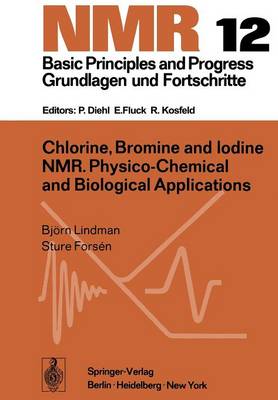NMR Basic Principles and Progress
2 primary works
Book 5
Nuclear magnetic resonance spectroscopy, which has evolved only within the last 20 years, has become one of the very important tools in chemistry and physics. The literature on its theory and application has grown immensely and a comprehensive and adequate treatment of all branches by one author, or even by several, becomes increasingly difficult. This series is planned to present articles written by experts working in various fields of nuclear magnetic resonance spectroscopy, and will contain review articles as well as progress reports and original work. Its main aim, however, is to fill a gap, existing in literature, by publishing articles written by specialists, which take the reader from the introductory stage to the latest development in the field. The editors are grateful to the authors for the time and effort spent in writing the articles, and for their invaluable cooperation. The Editors Analysis of NMR Spectra A Guide for Chemists R. A. HOFFMAN t S. FORSEN Division of Physical Chemistry, Chemical Center, Lund Institute of Technology, Lund, Sweden B. GESTBLOM Institute of Physics, University of Uppsala, Sweden Contents I. Principles of NMR Spectroscopy 4 1. 1. The Magnetic Resonance Phenomenon 4 a) Nuclear Moments. . . . . . . . 4 b) Magnetic Spin States and Energy Levels 5 c) The Magnetic Resonance Condition. 7 d) The Larmor Precession. . 7 e) Experimental Aspects . . . . 8 1. 2. Chemical Shifts . . . . . . . . 9 a) The Screening Constant 11. . . 9 b) Chemical Shift Scales (11 and r) 10 1. 3. Spin Coupling Constants 12 1. 4. Intensities. . . . . . . .
Book 12
The increasing interest in NMR spectroscopy of what in some confer ences in this field is commonly termed "other nuclei" is unmistakable. Chemists and biologists who employ NMR spectroscopy to study their problems have, however, been somewhat reluctant to study nuclei with electric quadrupole moments. These nuclei frequently give rise to broad NMR signals, sometimes too broad to be detectable with ordinary high resolution NMR spectrometers. Spectrometers that could cope with broad NMR signals of low intensity, "wide-line" spectrometers, have been available since the mid 1950:s but it appears that most of these instruments ended up in physical laboratories where the research was primarily directed towards solid state problems. The study of quadrupolar nuclei can provide unique and very valuable information on a variety of physico-chemical and biological systems. For one thing the relaxation of quadrupolar nuclei is in many ways easier to interpret than the relaxation of non-quadrupolar nuclei, since the former is in many cases caused by purely intramolecular interactions modulated by the molecular motion. Studies of quadrupolar relaxation have therefore furnished important information about molec ular reorientation and association in liquids and have played - and will certainly play for many years - an important role in testing new theoretical models of molecular motion in liquids.

